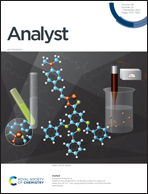A novel molecularly imprinted electrochemical sensor based on a nitrogen-doped graphene oxide quantum dot and molybdenum carbide nanocomposite for indometacin determination
Abstract
In this work, nitrogen-doped graphene oxide quantum dots (N-GOQDs) were embedded into Mo2C to prepare a nanocomposite with great electrical conductivity and a large specific surface area. We manufactured an innovative electrochemical sensor based on N-GOQDs–Mo2C and a molecularly imprinted polymer (MIP) for the highly sensitive detection of indometacin (IDMC). The MIP was synthesized by electropolymerization using acrylamide as the functional monomer and IDMC as the template molecule. N-GOQDs–Mo2C was organized by an elementary hydrothermal approach and characterized by SEM, TEM, XRD and FT-IR. In the first-rank experimental conditions, the MIP electrochemical sensor shows a wide linear range from 10−15 M to 10−5 M for IDMC detection and the detection limit is as low as 9.508 × 10−16 M. Additionally, the manufactured sensor shows great selectivity for indometacin, excellent repeatability and stableness. The sensor can be applied to the detection of indometacin in tablets and water samples with fulfilling consequence.



 Please wait while we load your content...
Please wait while we load your content...